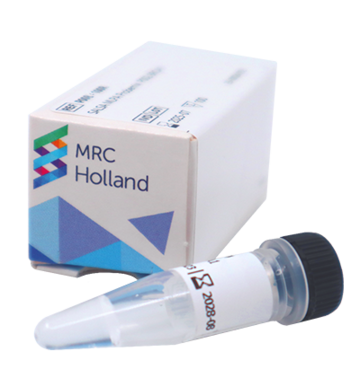The SALSA MLPA Probemix P099 GCH1-TH-SGCE-PRRT2 is a research use only (RUO) assay for the detection of deletions or duplications in the GCH1, TH, SGCE and PRRT2 genes, which are associated with autosomal dominant dopa-responsive dystonia, autosomal recessive dopa-responsive dystonia, myoclonus-dystonia syndrome and paroxysmal movement disorders, respectively.
Autosomal dominant dopa-responsive dystonia (also known as autosomal dominant Segawa syndrome or GTP Cyclohydrolase 1-Deficient Dopa-Responsive Dystonia; OMIM #128230) is characterised by postural and motor disturbances showing marked diurnal fluctuation (Segawa et al. 1976). The disorder is caused by a mutation in the GCH1 gene encoding GTP cyclohydrolase I. The GTP cyclohydrolase I enzyme is rate-limiting in the conversion of GTP to BH4, which is a cofactor for tyrosine hydroxylase (TH). TH is the rate-limiting enzyme for dopamine synthesis. The GCH1 gene has 6 exons, spans ~61 kb of genomic DNA and is located on chromosome 14q22.2, ~55 Mb from the p-telomere. More information is available at https://www.ncbi.nlm.nih.gov/books/NBK1508/.
The autosomal recessive form of dopa-responsive dystonia (also known as autosomal recessive Segawa syndrome or Tyrosine hydroxylase deficiency; OMIM #605407) is commonly caused by deficiency of TH (De Lonlay et al. 2000). TH is involved in the conversion of tyrosine to dopamine. As the rate-limiting enzyme in the synthesis of catecholamines, tyrosine hydroxylase has a key role in the physiology of adrenergic neurons. The TH gene is located in the Beckwith-Wiedemann syndrome (BWS) critical region (Gu et al. 2002) on chromosome 11p15.5. The TH gene has 14 exons and spans ~8 kb of genomic DNA, ~2 Mb from the p-telomere. More information is available at https://www.ncbi.nlm.nih.gov/books/NBK1437/.
Myoclonus-dystonia syndrome (OMIM #159900) is caused by mutations in the SGCE gene encoding epsilon-sarcoglycan. The SGCE gene has 11 exons, spans ~71 kb of genomic DNA and is located on chromosome 7q21.3, ~94 Mb from the p-telomere. More information is available at https://www.ncbi.nlm.nih.gov/books/NBK1414/.
Several paroxysmal movement disorders have been associated with the PRRT2 gene. In addition to these PRRT2-associated paroxysmal movement disorders, the gene has also been linked to other movement disorders and seizures. The PRRT2 gene has 4 exons, spans ~4 kb of genomic DNA and is located on chromosome 16p11.2, ~29 MB from the p-telomere. More information is available at https://www.ncbi.nlm.nih.gov/books/NBK475803/.





